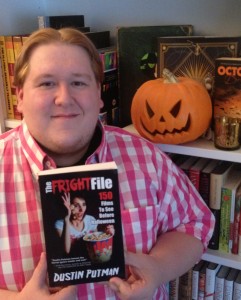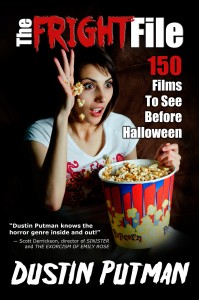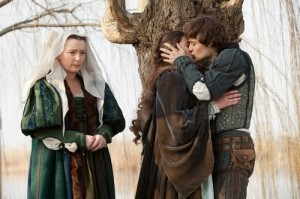It was a special treat to interview my friend Dustin Putman about his new book, The Fright File: 150 Films to See Before Halloween . As horror director Scott Derrickson says on the cover, “Dustin Putman knows the horror genre inside and out!”
. As horror director Scott Derrickson says on the cover, “Dustin Putman knows the horror genre inside and out!”
What’s the first scary movie you remember seeing?
A lot of my early childhood memories run together, but I do distinctly remember watching “Friday the 13th“ with my older brother, Rudy, one Saturday afternoon shortly after my family got our first VCR. I must have been four or five. It was also quite a personal triumph for me the first time I watched the macabre 1985 Disney sequel, “Return to Oz,” by myself. What an amazingly creepy film! Disney likely would never release something like that nowadays.
There are a lot of different kinds of scary — suspense, psychological, gory, monster. What makes each one work and which do you like best?
The great thing about the genre is that all of the above can work as long as there is a definite vision behind them, they are done well, and the filmmakers do not insult their audience. Passionate horror fans are actually quite discriminating, and when one works it can be one of the great movie-watching experiences. Supernatural horror can be fascinating and scary because it deals with the unknown—things that often cannot be explained. There is really nothing like psychological horror, especially from the 1970s, when studios were making films for adults rather than teenagers. 1973’s “The Exorcist,” and that same year’s unforgettably complex, chilling “Don’t Look Now,” directed by Nicolas Roeg and starring Donald Sutherland and Julie Christie, are two of my favorites. 1973 must have been a banner year. I also do still have a soft spot for slasher flicks, as well, probably because while growing up those were the ones I most gravitated toward. I should say there is a VERY fine line between a smart, scary, suspense-laden slasher and a lazy, derivative, throwaway one, which is what they tended to become as a result of the success of 1978’s “Halloween.”
There are a lot of horror/thriller movie series, including “A Nightmare on Elm Street” and “Halloween.” Which is your favorite?
When people ask me what my favorite horror movie is, I always have the same answer: John Carpenter’s “Halloween.” It is pretty much the epitome of perfection to me in cinema, a low-budget production made by talented young artists that relied on atmosphere, classical building of tension, memorable characters, frightening situations, fluid camerawork, and a brilliant instrumental score to tell a simple story brilliantly. It should also be mentioned that “Halloween” has little violence and almost no onscreen blood. These kinds of films quickly became more gory and almost pessimistic. “Halloween” cared about its characters and delivered a thrilling, inspiring experience.
Who is the all-time greatest horror movie villain and why? Which one has the best motive?
I will have to piggyback on my previous answer and say the killer from “Halloween,” Michael Myers. Before the sequel devised the whole brother-sister angle between he and Laurie Strode (Jamie Lee Curtis) and Rob Zombie tried to throw cockamamie explanations into his inferior 2007 remake, the most terrifying thing about Michael was that there was no motive at all. As psychiatrist Dr. Samuel Loomis (Donald Pleasence) explains in the film, he is “purely and simply evil.” This is much scarier to me because Michael isn’t just a mentally disturbed man, but, for all intents and purposes, the boogeyman.
Who is the all-time greatest horror movie director?
There are a lot of directors I admire, usually from different periods in their careers. 1970s/’80s-era John Carpenter is certainly up there (in little more than a decade’s time, he made “Halloween,” “The Fog,” “The Thing,” “Christine,” “Prince of Darkness,” and “They Live”). Wes Craven is responsible for two of my favorites, “A Nightmare on Elm Street” and “Scream.” More recently, Ti West is, for me, a modern-day master. His movies are all different in story, but very specifically his own style. It is quite telling that every film of his that has been released, to date, made it into my book, “The Fright File,” including 2005’s underseen gem “The Roost,” 2007’s even more underseen thriller “Trigger Man,” 2009’s “The House of the Devil,” and 2011’s “The Innkeepers.”
Without giving it away, which movie has the best twist ending?
There are two that come to mind, and they are both impossible to forget for anyone who has seen them: 1983’s “Sleepaway Camp” and 1999’s “The Sixth Sense.” I can’t give them away, obviously, but they were both impeccably constructed in a way that surprised upon first viewing and hold up on successive revisits even after you know the “truth.”
 How do American horror movies differ from those made in other countries?
How do American horror movies differ from those made in other countries?
My temptation is to say that horror movies from other countries are smarter than American ones, but this would actually be a gross generalization. There are plenty of outstanding U.S.-made horror efforts, and a lot of foreign titles that aren’t very good. One distinction, I think, is that genre movies from other countries tend to be more courageous and cerebral and trend-setting, while American horror is perhaps more concerned with the bottom line and trying to recreate past successes. This is why we see so many remakes these days, and went through a phase a few years back where every Japanese horror title was being redone in the States.
Horror movies get remade a lot — which is the best remake? Which is the worst?
Best remakes: 2004’s “Dawn of the Dead,” directed by Zack Snyder, did a fabulous job of updating the story and putting a fresh spin on the subject while still adhering to the spirit of the Romero classic. Also, I thought 2010’s “Let Me In,” a remake of “Let the Right One In,” actually improved upon the acclaimed Swedish original by adding underlying layers involving the political climate and so-called “Satanic Panic” of the 1980s.
Worst remakes: 2005’s “The Fog” and 2006’s “The Wicker Man.” Both of these were disasters, missing the entire points of their predecessors. Every possible bad decision one could imagine seemed to be made tenfold when these updates were put in front of the camera. At least Rob Zombie’s “Halloween,” which I am not a fan of, had an undeniable vision behind it. “The Fog” and “The Wicker Man” were two examples of remakes made by committee, with zero creative insight.
What do you love most about horror?
The horror genre is one of a kind in the way that it can play so heavily on the viewer’s deeper emotions. An effective horror film can be an incredibly cathartic experience, and a whole lot of fun. Also, because many of them deal with very extreme situations and ideas, there is more room to explore different themes and use fantastical or frightful subject matter as metaphor for larger universal topics. This is why, I believe, so much has been written on the subject of horror; its scope, and where filmmakers can take their stories, is boundless.
Dustin’s reviews of hundreds of movies in every genre are available at DustinPutman.com
, featuring roasts honoring Bob Hope, Johnny Carson, Jimmy Stewart, Sammy Davis, Jr., Jack Benny, Lucille Ball, Kirk Douglas, Michael Landon, Jackie Gleason, Don Rickles, Joan Collins, and the man himself, Dean Martin. Roasting them are a full collection of 70’s luminaries, including Muhammad Ali, George Burns, Florence Henderson, Bette Davis, Phyllis Diller, and Milton Berle. A warning on the package cautions that the racial and ethnic humor of the era may seem inappropriate by today’s standards (on the other hand, if those folks ever heard the jokes at today’s events, they would be very surprised by the explicitly raunchy humor). “Keep in mind the tenor of the times, the bawdy party atmosphere, and the fact that many of these celebrities were friends who loved to give and take a good shot. The cigarettes are real, the drinks are free, and the camaraderie is heartfelt.”




